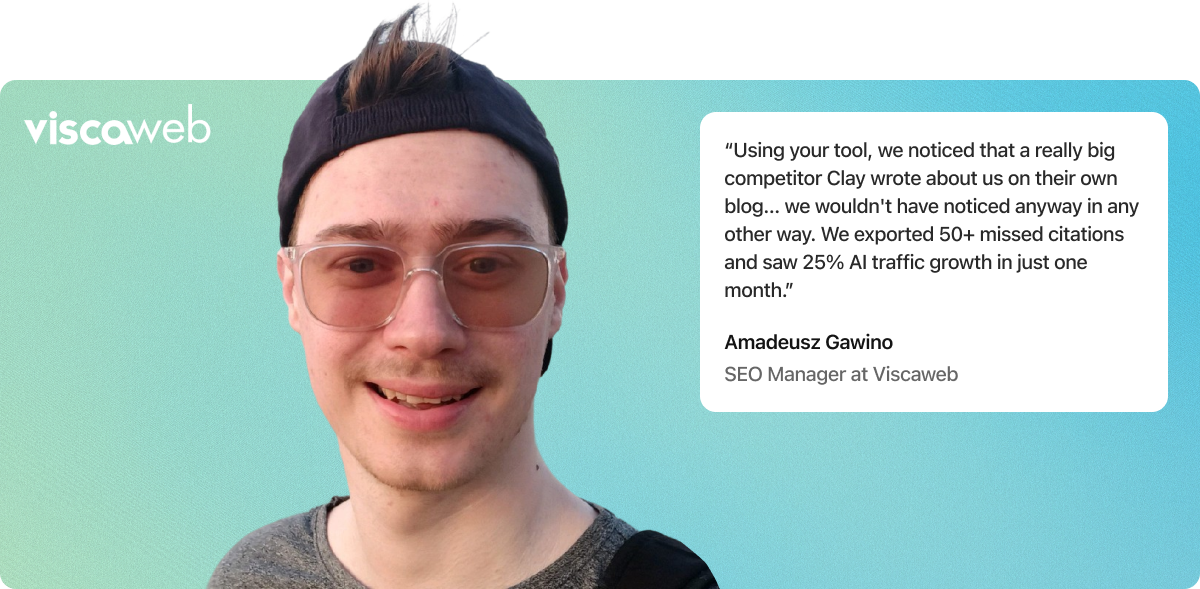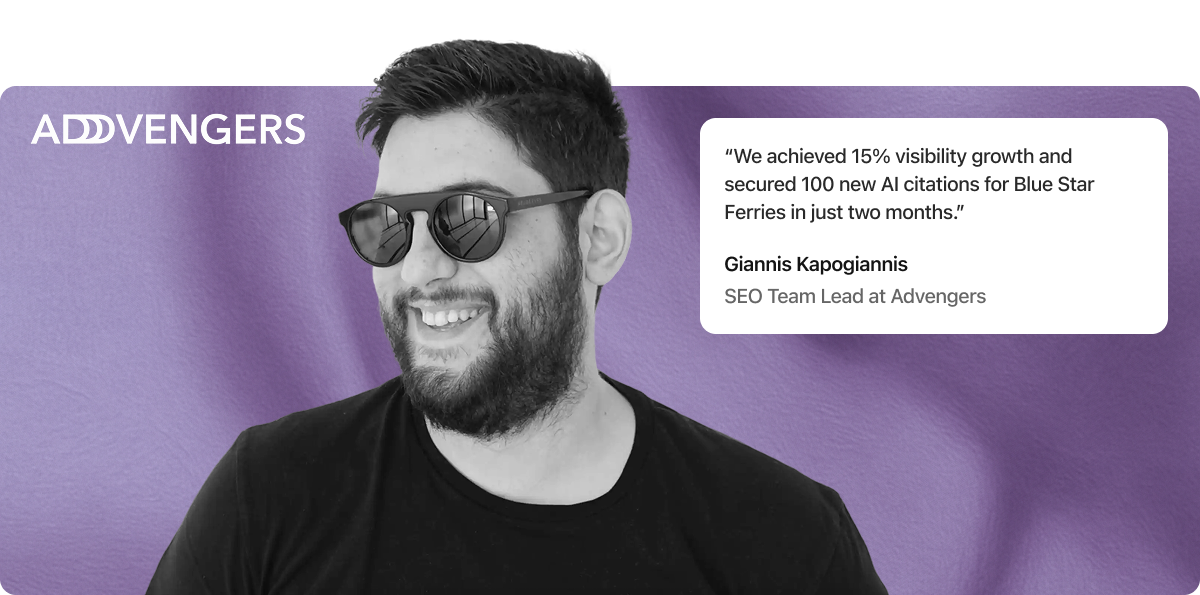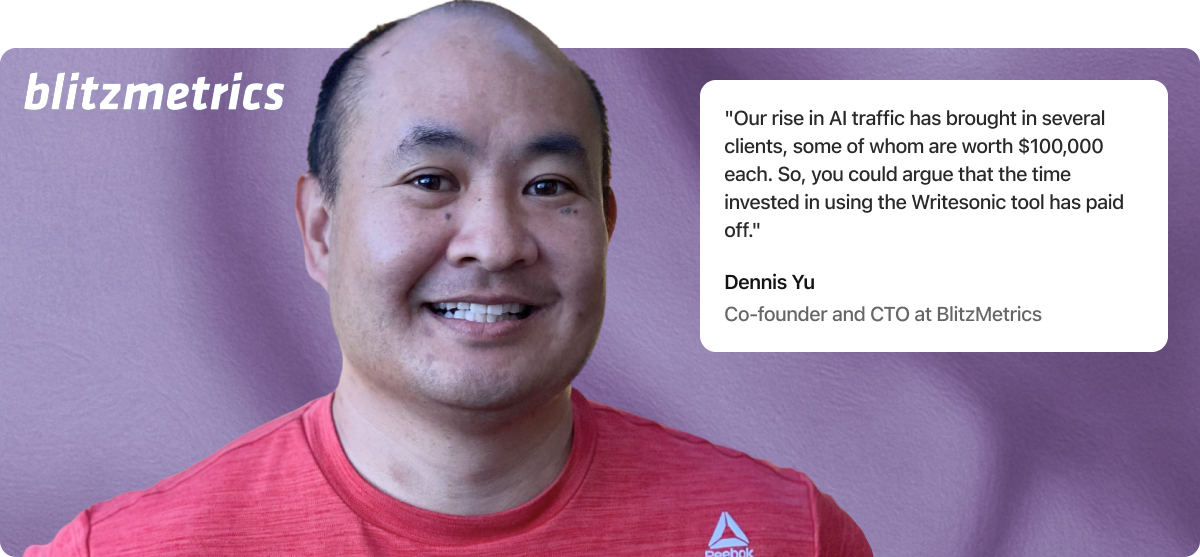When you're managing multiple business verticals—from sports betting affiliate sites to SaaS lead generation tools—staying ahead of the competition requires constant vigilance. For Amadeusz Gawino and his team at Viscaweb, that vigilance led to discoveries that traditional SEO tools had completely missed.
"Using your tool, we noticed that a really big competitor Clay wrote about us on their own blog… we wouldn't have noticed anyway in any other way," reveals Amadeusz. This wasn't just a mention—it was intelligence gold that opened doors to understanding competitive dynamics they never knew existed.
But this competitor mention was just the beginning of what Writesonic's GEO platform would reveal about their invisible presence in AI search.
The Challenge: Tracking Success Across Multiple Business Lines
As SEO experts managing diverse business verticals, Viscaweb faced a unique challenge. "Everyone in the industry now is like ranking in AI also matters. It's not only ranking in Google. But also in LLMs," explains Amadeusz. "We want some way to track it, basically. Because as we track our SEO, we want to track it."
Their portfolio included:
- Sports betting affiliate websites with established brands targeting the US market
- A newly acquired SaaS product for lead generation that scrapes emails from the internet
- Multiple client properties across different industries
Traditional SEO tools showed them keyword rankings and backlinks, but couldn't answer critical questions: Were their brands being recommended by ChatGPT? Which competitors were dominating AI responses? Where were the gaps they could exploit?
"We both, me and Marc, we are SEO people. We do SEO, and we rank our own websites for affiliate marketing," Amadeusz explains. "But we realized we needed to extend beyond traditional search into AI visibility."
Uncovering Hidden Intelligence That Traditional Tools Missed
Within weeks of implementing Writesonic, Viscaweb discovered competitive intelligence that had been completely invisible to traditional SEO tools.
The breakthrough moment came when they discovered Clay had written about them. "It was not a link. So it was like, citation, but without the link but our competitor wrote about us about our brand on their own blog," Amadeusz explains. "It was something like the blog post of top email marketing, something lead generation. Like five top tools here and they listed us."
This discovery was game-changing for multiple reasons:
Immediate Value: Clay had essentially validated Viscaweb as a legitimate competitor worth discussing Partnership Potential: The mention opened doors for potential collaboration or reciprocal coverage
Intelligence Gathering: It revealed Clay's content strategy and how they positioned competitors SEO Opportunity: They could leverage this mention for link building and relationship development
"Two weeks ago. We wouldn't have noticed anyway in any other way," Amadeusz emphasizes. "Your tool checked it here, like it noticed it."
Systematic Discovery of Citation Opportunities
Beyond the Clay discovery, Writesonic revealed a systematic approach to finding missed opportunities that traditional tools had overlooked.
"We exported the list using your tool of those missed citations. And now our team is gonna try to engage with those blogs to ask for the citation to mention our brand," shares Amadeusz. This proactive approach revealed over 50 potential citation opportunities where competitors were mentioned but Viscaweb was ignored.
The process became systematic and actionable:
Step 1: Gap Identification "Some URLs are like lists of blog posts and blog lists like the best tools in the market. But for example, we are not there," Amadeusz notes. The platform showed exactly which high-authority sites mentioned competitors but not Viscaweb.
Step 2: Competitive Intelligence
They discovered competitors appearing in specific forums, industry publications, and niche websites they'd never considered. Each gap represented a potential citation opportunity.
Step 3: Outreach Strategy "So this really useful because to find it manually with other tools, it was difficult," explains Amadeusz. Instead of cold prospecting, their outreach team now had a precise target list of sites already discussing their industry.
Early Results Show Promise Despite Modest Scale
Within their first month of implementation, the results began materializing in measurable ways:
AI Traffic Growth: Monthly users from AI platforms increased from 221 to 277—a 25% month-over-month growthBusiness Impact: Generated "2 point something purchases" from AI traffic
Discovery Intelligence: 50+ citation opportunities identified across multiple business verticals
Competitive Insights: Deep understanding of where competitors dominate and why
"We track it meticulously in Google Analytics. We have a custom dashboard that specifically tracks AI and LLM traffic," explains Amadeusz. This dual-tracking approach proved invaluable for measuring both traditional and AI-driven performance.
While the numbers were promising, Amadeusz remained realistic about the scale. "It's not yet spectacular. The gains, if there were some gains, they were not so spectacular that we would alert the rest of the team like 'Oh look, from LLMs now we have massive traffic.' This is not yet the case."
However, the trend was clear and growing. "It's like a slow incremental raise in users," notes Amadeusz. More importantly, the citation opportunities represented potential business value far exceeding the current traffic numbers.
From Reactive to Proactive: Building an AI-First Strategy
The transition required a fundamental shift in thinking. While maintaining their strong traditional SEO foundation, Viscaweb began incorporating AI visibility metrics into their core strategy.
"Sometimes it's not directly correlated. But why? If in SERPs it doesn't do well, also in the LLMs it won't be surfaced as well," Amadeusz notes, highlighting the interconnected nature of traditional and AI search.
Their approach became systematic:
Content Strategy Evolution: Creating content designed for both traditional and AI consumption Monitoring Integration: Weekly tracking of AI visibility alongside traditional SEO metrics
Outreach Precision: Targeting specific publications where competitors gain citations but they don't Technical Optimization: Ensuring their sites are properly crawlable by AI platforms
The team particularly valued understanding the volatility of AI search results. "There is this graph of visibility. I was wondering why the visibility changes so much over time. Sometimes from day to day, it's 100%, then it drops to zero, then it goes to 50," Amadeusz observed, learning to focus on weekly and monthly trends rather than daily fluctuations.
Looking Forward: Building Long-Term Competitive Advantages
Six months after implementation, Viscaweb sees AI visibility as a competitive moat rather than just another metric to track.
They're particularly excited about the Action Center features for systematic improvement. "This is very interesting… we had troubles with finding those threads. Now we could have a list of the Reddit posts and send for our team to comment," says Amadeusz, highlighting how the platform streamlines previously manual processes.
The agency is now applying their learnings across:
- Sports betting affiliate sites: Targeting gambling and sports-related AI queries
- SaaS lead generation tools: Optimizing for business software recommendations
- Systematic outreach: Using citation gap analysis for strategic relationship building
For agencies looking to establish AI search presence, Amadeusz emphasizes patience and systematic execution. "It's not spectacular yet, but we're seeing consistent improvement. It's like a slow incremental raise, and that's what matters for long-term success."
The real value isn't just in the current traffic numbers—it's in the competitive intelligence and systematic opportunities that traditional tools simply cannot provide. "To find it manually with other tools, it was difficult," Amadeusz concludes. "Now we have a systematic way to discover what we were missing."



























